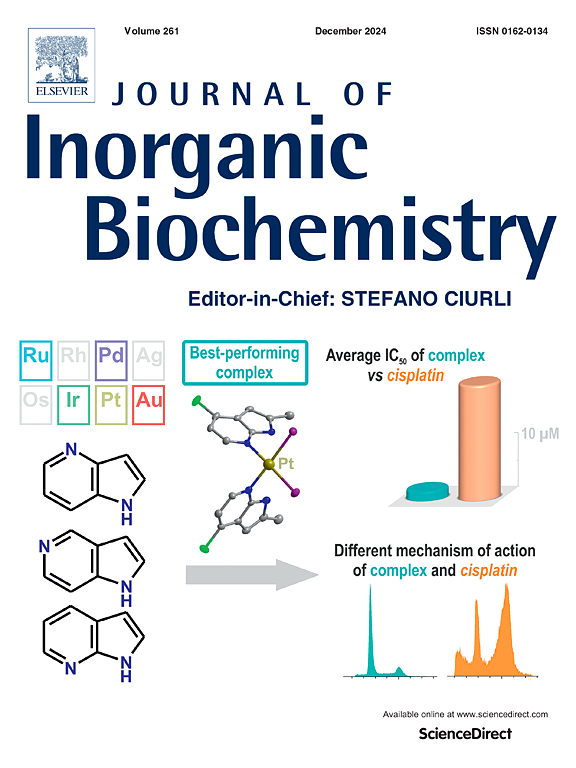The interplay between the myeloperoxidase-hypochlorous acid system, heme oxygenase, and free iron in inflammatory diseases
IF 3.2
2区 化学
Q2 BIOCHEMISTRY & MOLECULAR BIOLOGY
引用次数: 0
Abstract
Accumulated unbound free iron (Fe(II or III)) is a redox engine generating reactive oxygen species (ROS) that promote oxidative stress and inflammation. Iron is implicated in diseases with free radical pathology including cardiovascular, neurodegenerative, reproductive disorders, and some types of cancer. While many studies focus on iron overload disorders, few explore the potential link between the myeloperoxidase-hypochlorous acid (MPO-HOCl) system and localized iron accumulation through heme and iron‑sulfur (Fe![]() S) cluster protein destruction. Although inducible heme oxygenase (HO-1), the rate-limiting enzyme in heme catabolism, is frequently associated with these diseases, we hypothesize that HOCl also contributes to the generation of free iron and heme degradation products. Furthermore, HO-1 and HOCl may play a dual role in free iron accumulation by regulating the activity of key iron metabolism proteins. Enzymatic and non-enzymatic modulators, as well as scavengers of HOCl, can help prevent heme destruction and reduce the accumulation of free iron. Given iron's role in disease progression and severity, identifying the primary sources, mechanisms, and mediators involved in free iron generation is crucial for developing effective pharmacological treatments. Further investigation focusing on the specific contributions of the MPO-HOCl system and free iron is necessary to explore novel strategies to mitigate its harmful effects in biological systems.
S) cluster protein destruction. Although inducible heme oxygenase (HO-1), the rate-limiting enzyme in heme catabolism, is frequently associated with these diseases, we hypothesize that HOCl also contributes to the generation of free iron and heme degradation products. Furthermore, HO-1 and HOCl may play a dual role in free iron accumulation by regulating the activity of key iron metabolism proteins. Enzymatic and non-enzymatic modulators, as well as scavengers of HOCl, can help prevent heme destruction and reduce the accumulation of free iron. Given iron's role in disease progression and severity, identifying the primary sources, mechanisms, and mediators involved in free iron generation is crucial for developing effective pharmacological treatments. Further investigation focusing on the specific contributions of the MPO-HOCl system and free iron is necessary to explore novel strategies to mitigate its harmful effects in biological systems.

髓过氧化物酶-次氯酸系统、血红素加氧酶和游离铁在炎性疾病中的相互作用
积累的未结合的游离铁(Fe(II或III))是氧化还原引擎,产生活性氧(ROS),促进氧化应激和炎症。铁与自由基病理疾病有关,包括心血管疾病、神经退行性疾病、生殖疾病和某些类型的癌症。虽然许多研究都集中在铁超载疾病上,但很少有人探索髓过氧化物酶-次氯酸(MPO-HOCl)系统与通过血红素和铁硫(FeS)簇蛋白破坏的局部铁积累之间的潜在联系。虽然诱导血红素加氧酶(HO-1)是血红素分解代谢的限速酶,经常与这些疾病有关,但我们假设HOCl也有助于游离铁和血红素降解产物的产生。此外,HO-1和HOCl可能通过调节关键铁代谢蛋白的活性,在游离铁积累中发挥双重作用。酶和非酶调节剂,以及HOCl的清除剂,可以帮助防止血红素破坏和减少游离铁的积累。鉴于铁在疾病进展和严重程度中的作用,确定游离铁生成的主要来源、机制和介质对于开发有效的药物治疗至关重要。进一步研究MPO-HOCl体系和游离铁的具体作用对于探索减轻其在生物系统中的有害影响的新策略是必要的。
本文章由计算机程序翻译,如有差异,请以英文原文为准。
求助全文
约1分钟内获得全文
求助全文
来源期刊

Journal of Inorganic Biochemistry
生物-生化与分子生物学
CiteScore
7.00
自引率
10.30%
发文量
336
审稿时长
41 days
期刊介绍:
The Journal of Inorganic Biochemistry is an established international forum for research in all aspects of Biological Inorganic Chemistry. Original papers of a high scientific level are published in the form of Articles (full length papers), Short Communications, Focused Reviews and Bioinorganic Methods. Topics include: the chemistry, structure and function of metalloenzymes; the interaction of inorganic ions and molecules with proteins and nucleic acids; the synthesis and properties of coordination complexes of biological interest including both structural and functional model systems; the function of metal- containing systems in the regulation of gene expression; the role of metals in medicine; the application of spectroscopic methods to determine the structure of metallobiomolecules; the preparation and characterization of metal-based biomaterials; and related systems. The emphasis of the Journal is on the structure and mechanism of action of metallobiomolecules.
 求助内容:
求助内容: 应助结果提醒方式:
应助结果提醒方式:


